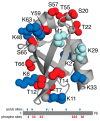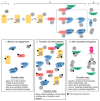Acetylation, Phosphorylation, Ubiquitination (Oh My!): Following Post-Translational Modifications on the Ubiquitin Road
- PMID: 35327659
- PMCID: PMC8946176
- DOI: 10.3390/biom12030467
Acetylation, Phosphorylation, Ubiquitination (Oh My!): Following Post-Translational Modifications on the Ubiquitin Road
Abstract
Ubiquitination is controlled by a series of E1, E2, and E3 enzymes that can ligate ubiquitin to cellular proteins and dictate the turnover of a substrate and the outcome of signalling events such as DNA damage repair and cell cycle. This process is complex due to the combinatorial power of ~35 E2 and ~1000 E3 enzymes involved and the multiple lysine residues on ubiquitin that can be used to assemble polyubiquitin chains. Recently, mass spectrometric methods have identified that most enzymes in the ubiquitination cascade can be further modified through acetylation or phosphorylation under particular cellular conditions and altered modifications have been noted in different cancers and neurodegenerative diseases. This review provides a cohesive summary of ubiquitination, acetylation, and phosphorylation sites in ubiquitin, the human E1 enzyme UBA1, all E2 enzymes, and some representative E3 enzymes. The potential impacts these post-translational modifications might have on each protein function are highlighted, as well as the observations from human disease.
Keywords: acetylation; cancer; neurodegenerative disease; phosphorylation; protein structure; proteomics; ubiquitination.
Conflict of interest statement
The authors declare no conflict of interest.
Figures




References
Publication types
MeSH terms
Substances
LinkOut - more resources
Full Text Sources
Other Literature Sources
Research Materials
Miscellaneous

